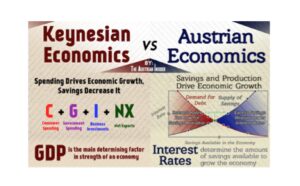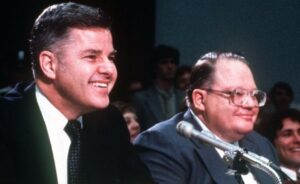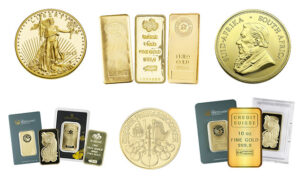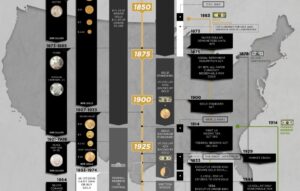This week, 110 years ago, a secret meeting on a secluded Georgia island brought together six of the world’s most influential figures.
Their objective?
To lay the foundation for the United States’ Central Bank, now known as the Federal Reserve. This momentous gathering not only reshaped America’s monetary policy but has also remained a largely unknown piece of history for years…
We’ll talk more about this extremely little-known piece of history in just a moment – but first let’s see what’s in the news and test your knowledge with this week’s trivia question…
The Ultimate Measure of Purity
Gold’s purity is measured in karats, with 24 karats equaling pure gold. However, pure 24k gold is actually too malleable for everyday use. The purest gold used for jewelry is 22k, which is 91.67% gold. Most gold jewelry you see in the mall is only 14k gold, comprised of 58.3% gold and 41.7% other metals such as silver, copper, and zinc.
Last Fed Meeting Saw Unchanged Key Interest Rates
The Federal Reserve kept its key interest rate unchanged (at 5.33%) on December 13, 2023, for the third consecutive time. Officials from the Federal Reserve have signaled the possibility of rate cuts in the future. However, the timing and extent of these potential cuts remain a topic of discussion and speculation.
The Golden Mask of King Tutankhamun
One of the most famous gold artifacts in history is the funeral mask of the Egyptian Pharaoh Tutankhamun. Weighing over 22 pounds (321.5 troy ounces) and made of 22.5k gold, it bears the likeness of Osiris, Egyptian god of the afterlife.

In 1324, this renowned leader distributed so much gold during his pilgrimage to Mecca, he unintentionally devalued gold regionally, causing economic inflation that took 12 years to stabilize.
A. Emperor Newaya Krestos, Ethiopia
B. Mansa Musa, Mali
C. King Tsamiya, Nigeria
D. King Barschanbu, Sudan
Scroll to the bottom of this email for the answer…
Secrets of Jekyll Island
The Covert Meeting that Reshaped American Banking

In the early 1900s, the United States was plagued by financial instability. The Panic of 1907, a particularly devastating crisis, had exposed critical weaknesses in America’s banking system. It was against this backdrop that a secret meeting, one that would profoundly reshape American finance, took place.
Nestled off the coast of Georgia, Jekyll Island was not widely known, yet it held an exclusive allure. Described in 1904 by Munsey’s Magazine as “the richest, the most exclusive, the most inaccessible club in the world,” it presented the perfect refuge for a secretive and significant gathering.
In November of 1910, U.S. Senator Nelson Aldrich of Rhode Island, accompanied by five key figures from America’s banking elite, set off on a covert retreat to Jekyll Island. The attendees included A. Piatt Andrew, Henry Davison, Arthur Shelton, Frank Vanderlip, and Paul Warburg.
While in transit to the island, via railroad car, the six men referred to each other by first name only, to prevent waitstaff or anyone within earshot from recognizing them. Under the guise of a gentlemen’s duck hunt, they avoided the prying eyes of the press. One member even carried a borrowed shotgun to maintain this ruse.
However, their true aim was far from leisure – the ideas formed at Jekyll Island became the backbone of the legislation that would later be called the Federal Reserve Act. And for over two decades, the true nature of this meeting remained a closely guarded secret, only coming to light in the 1930s.
The Creation of the Federal Reserve
At Jekyll Island, Aldrich and the bankers came up with a plan. They knew many Americans would be wary of a central bank because it could become too powerful. So, they came up with another proposal with a similar goal in mind.
Their proposal: to create a series of 15 regional branches in cities like Dallas, Richmond, and New York, each governed by directors from member banks. This plan, later presented as the National Reserve Association in 1911, aimed to balance regional banking interests with national oversight.
Crafting the Federal Reserve in Secrecy
The journey to the Federal Reserve Act of 1913 was fraught with controversy and secrecy. The initial plan, conceived in secret by key financial figures on Jekyll Island, faced strong opposition in Congress due to widespread public mistrust of a central bank. Many worried, rightfully so, that central banking powers could be abused in the wrong hands.
Despite this, the Federal Reserve Act of 1913 was signed into law by President Woodrow Wilson on December 23, 1913, resembling the original proposal Senator Aldrich created at Jekyll Island.
The Veil of Secrecy at Jekyll Island
The covert nature of the Jekyll Island meeting was so well-guarded that even when Forbes mentioned it in 1917 in “Men Who Are Making America”, it largely went unnoticed or was dismissed as fiction.
The participants themselves vehemently denied the meeting for two decades, only acknowledging it following the publication of Aldrich’s biography in 1930. This delay in admission shows the founders’ awareness of the plan’s potential unpopularity and the lengths they went to conceal their involvement.
The Federal Reserve Act of 1913
Their original plan was initially shot down in Congress. The plan for a central bank was fiercely debated as many were strongly opposed to the idea. Despite the opposition, the final Act, passed in December 1913, closely mirrored Aldrich’s initial proposal. And on Dec. 23, 1913, President Woodrow Wilson signed the Federal Reserve Act into law.
As we now know, the establishment of the Federal Reserve didn’t immediately bring economic stability, like it was promised. In fact, its early policies are often criticized for exacerbating the Great Depression.
Despite its aim to curb financial instability, the Federal Reserve has witnessed dozens of substantial economic downturns, including the Dot-com crash, the 2008 Financial Crisis, and the COVID-19 economic impact.
And the Fed certainly hasn’t done anything to help preserve the buying power of the dollar.
U.S. Dollar has Lost 96.8% of Its Purchasing Power
Since the Creation of the Fed

If you held a fixed amount of dollars since 1913, you’d only be able to buy 3.2% of the stuff today that you could’ve purchased back then. But if you held the same amount of gold instead? You’d be able to buy 315% worth of goods. More than triple the stuff! That’s a difference of nearly 100x more purchasing power between the two assets, and it’s because gold’s price – measured in dollars – has risen nearly 100x since 1913.
If you don’t own any gold or silver, now’s the time to get some. We make it as easy as possible to get started, no matter how much experience you may have investing in precious metals.
That’s it for this week’s GoldSilver Nuggets email. We’ll be back next week!
Best,
Brandon S.
GoldSilver


In 1324, this renowned leader distributed so much gold during his pilgrimage to Mecca, he unintentionally devalued gold regionally, causing economic inflation that took 12 years to stabilize.
A. Emperor Newaya Krestos, Ethiopia
B. Mansa Musa, Mali
C. King Tsamiya, Nigeria
D. King Barschanbu, Sudan
Answer – B. Mansa Musa, Mali
During his journey, Mansa Musa passed through Cairo and other cities, where he reportedly distributed so much gold that he inadvertently caused a significant devaluation of gold in the regions he visited. The influx of gold was so substantial that it depressed its value, leading to economic inflation that took more than a decade to correct.
Some estimates say he was worth the equivalent of $400 billion today, although many historians argue that it’s hard to pinpoint an exact number.








